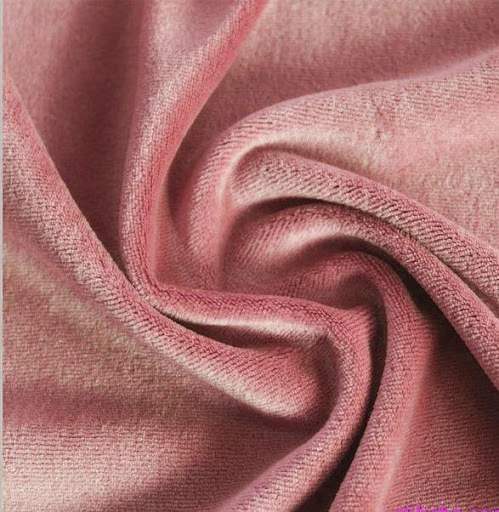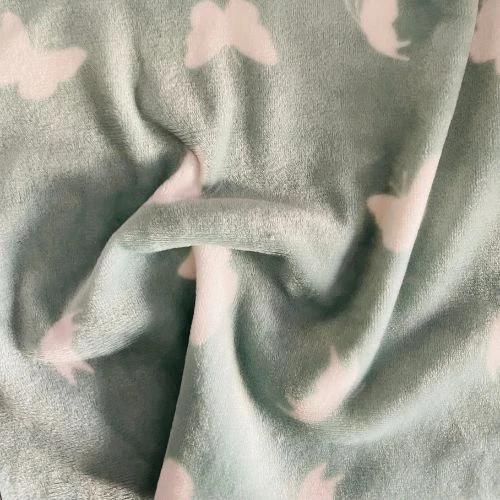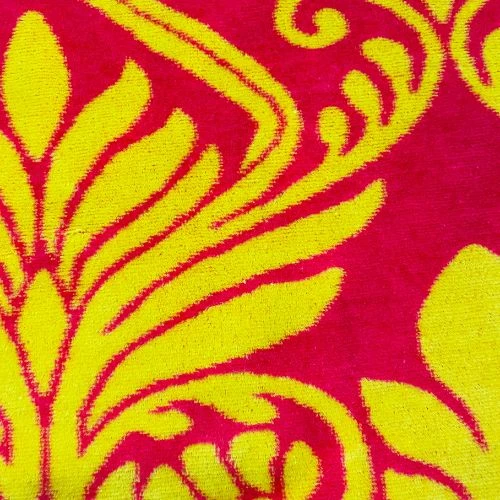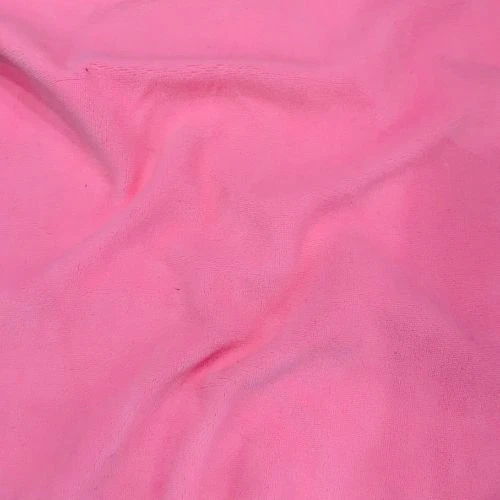Velvet and Velour are the two most popular fabrics in the textile industry. These two fabrics come with exclusive features and are used to manufacture different applications. Although these fabrics are almost the same in terms of functionalities, several things set them apart from each other. So, are you willing to know the differences between Velvet vs velour fabric?
Velour vs Velvet Quick Comperision are:
|
Criteria |
Velvet Fabric |
Velour Fabric |
| Main Difference: | Pile Hight longer and more flowing. | Pile height is short and dense. |
|
Manufacturing Process |
Traditionally Woven fabric; is a pile formed by cutting looped fibers during weaving. But now produced with a knit base. |
Knitted fabric; pile created by cutting loops in a knitted structure. |
|
Appearance |
Luxurious, smooth, and shiny surface with a dense pile. |
Soft, plush, and matte appearance; slightly less lustrous than velvet. |
|
GSM Range |
200–500 GSM |
180–400 GSM |
|
Composition Range |
Cotton, silk, rayon, polyester, or nylon. |
Cotton-polyester blends, or 100% polyester. |
|
Construction Range |
Woven in plain or twill weave; high-density construction. |
Circular knit construction, often with a stretch base. |
|
Functionality |
Available with TPU, PU, or AC finishes for water resistance and durability. |
May include PU or PVC backing for stretch and water resistance. |
|
Thread Density Range |
Typically 250T–400T. |
Generally not applicable due to knit structure. |
|
Count Variations |
Yarn counts range from 30s to 80s for smoothness. |
Variable yarn sizes, with finer counts for lightweight applications. |
|
Fabric Breathability |
Moderate; not highly breathable due to dense pile. |
Good; breathable due to the knitted structure. |
|
Moisture-Wicking Abilities |
Low; retains moisture due to dense pile. |
Moderate to high; depending on fiber composition and finishes. |
|
Heat Retention Abilities |
Excellent; traps air in the pile, providing warmth. |
Good; retains heat but less than velvet. |
|
Stretchability |
Limited; non-stretch fabric unless blended with spandex. |
High; inherent stretch due to knit construction. |
|
Prone to Pilling/Bubbling |
Less prone; tightly woven structure minimizes pilling. |
More prone; knitted structure and lower density increase pilling risk. |
|
First Produced (Country) |
Iraq (as early as the 14th century). |
France (19th century). |
|
Biggest Exporter (Quantity) |
China (~70% of global production). |
China (~60% of global production). |
|
Recommended Washing Temp. |
Cold wash (<30°C) to avoid damage to pile. |
Gentle wash (<40°C); avoid high heat during drying. |
|
Applications |
Evening wear, upholstery, drapes, and accessories. |
Sportswear, casual wear, costumes, and children’s clothing. |
Velvet and Velour are almost identical in terms of functionalities. However, Velvet has more breathability, sheen, and durability than Velour. On the other hand, Velour has much more stretchability; it is lightweight and comfortable.
Table Of Contents
What is Velvet Fabric?
Velvet Fabric is among the most opulent, gleaming, and costly textiles available. It has the tallest pile and also is the heaviest of the bunch. It's commonly constructed of silk, rayon, as well as polyester combination. It has a lengthy looped nap that may be darker or brighter depending on which way you put your palm. Velvet is distinguished by its suppleness and lustrous shine.
_1699618206.webp)
The large loops aid the fabric's silky feel. There is no stretch since it is woven, yet it drapes beautifully. It's also often constructed with long filament strands, adding to its perfect image by employing only the finest fibers. Due to the apparent threads, it generally has a higher gloss than Velour. The fabric is very costly due to the principal fiber having silk.
Velvet velveteen is a fabric that falls between Velvet and Velour. It has a somewhat higher density than Velvet; however, its cut pile is shorter. Over Velour and velveteen, Velvet is the higher-quality, more costly foundation fabric. Velvet was formerly a cloth reserved for royalty, nobles, and the affluent in the Middle East. Velvet is now more commonly accessible among the general populace.
Let's Learn about Trending 9 Types of Velvet Fabric You Should Know
What is Velour Fabric?
Velour is a kind of knitted fabric that features a cut pile. It has a pile knit pattern, which means the yarns, which are commonly composed of cotton as well as synthetics, are woven into loops, similar to a pile weave. Polycotton, , cotton and synthetic combination are currently used to make contemporary Velour.

Velour is a kind of fabric that is highly comparable to Velvet in terms of its plushness and incredible softness. Unlike Velvet, which would be a pile weaving fabric, Velour is indeed a pile knit textile, which means it is less luxurious and easier to create. Velour is a more stable version of Velvet that retains many of the attractive qualities of the opulent fabric. Its widespread usage as a theatrical curtain material is a result of this.
Velour is practically a protest against the aesthetic and sociological constructions of the 1960s and 1970s; it became the material of a generation. It was nearly the complete antithesis of the fitted, well-put-together attire that's on for both ladies and men, being soft, comfy, and colorful. Sportswear firms have created trademark tracksuits as well as sports gear utilizing the exceptionally soft material, which has been welcomed with wide arms.
Did you want to know details about it? Check out Best Things You Should Know About Velour Fabric?
Differences between Velvet and velour
Let's take a look at the key differences between Velvet vs velour fabric.
1. Manufacturing materials
The first and foremost thing that sets these two fabrics apart from each other is their manufacturing materials. The traditional velvet fabric is made of silk. However, modern velvet fabric can be manufactured from wool, linen, as well as polyester materials.
One thing we should mention is that cotton is a less-used fiber to manufacture velvet fabric. On the other hand, Velour is a kind of popular fabric that is made of cotton. This fabric can also be produced from synthetic materials. It is also possible to manufacture velour fabric from a blend of cotton and synthetic materials.
2. Weaving Process
Aside from being constructed of different fibers, the weaving method varies somewhat as well. To manufacture velour fabric, the threads are looped together to form a pile weave. Small loops are then chopped off, causing the finished product to lose its luster. Velvet, on the other hand, is woven on a unique loom that combines two layers.
After that, the two parts are torn apart to create the tufted soft pile look, and the layers are twisted on separate rolls. Prior industrial power looms were accessible, but manufacturing velvet material was difficult and also time-consuming and challenging. And all of this contributed to the fabric's increased price.
3. Fabric Breathability
Fabric breathability is one of the most notable features of any fabric. This feature mainly depends on the manufacturing materials of the fabric. The breathability of Velvet is determined by whether or not it is based on linen. The use of linen imparts a light as well as breathable quality to Velvet. Because it is made with linen fiber, this sort of Velvet will have the airy properties that linen is known for.
Velour is often made of synthetic materials. The vast majority of synthetic materials are not breathable. Cotton velour will have the qualities of cotton cloth, including some breathability since cotton is a naturally breathable material. It is generally agreed that neither Velour nor Velvet is the type of cloth that is best suited for use in warm weather or in hotter climes. They are often thought of as contributing to one's ability to remain warm.
4. Fabric Texture
The fabric texture is one of the most important things that you should consider before investing in new fabric. The Velour and the velvet fabric both come with a satisfying level of texture. Both these two fabrics have amazing soft as well as luxurious finishing. Both fabrics are silky and have a one-way nap formed by little thread loops.
The tiny loops that are formed by the threads are what give Velvet its lustrous gloss. Velour is created by cutting these loops, which results in a significant reduction in the quantity of shine. Velour is not as shiny as Velvet because of this difference.
5. Fabric Stretchability
In general, Velvet is utilized more often for projects that call for drape rather than those that demand it to be form-fitting. It is a structured fabric that is used for upholstery as well as curtains, and it is better recognized for the rich and luxurious feeling that it can provide a space when used in such capacities.
On the other hand, Velour has a greater degree of elasticity than Velvet does. Velour has a natural flexibility due to the fact that it is knit fabric. The use of synthetic fibers in its construction is also quite plausible. Velour is the best material to choose for your stretchable project because to both of these reasons.
6. Fabric Comfortability
Fabric comfortability is another feature that sets the velvet and velour fabric apart from each other. Velour is a more comfortable fabric than velvet fabric. This fabric is not only comfortable; it also comes with lightweight features. As a consequence of this, it is far less common to come across clothing made of Velvet.
On the other hand, Velvet is a woven fabric that is relatively bulkier than properties of velour fabric. Velvet's wide pile makes it a suitable fabric for jewelry as well as gemstone protection covers and wraps. Its construction and solidity make it a long-lasting alternative for storing your valuables.
Summary Feature Difference of Velvet and Velour
Let's wrap it up the key differences between Velvet and Velour:
| Feature | Velvet | Velour |
|---|---|---|
| Fabric Composition | Typically made of silk, cotton, or synthetics | Usually composed of cotton, polyester, or a blend of materials |
| Texture | Smooth, soft, and luxurious | Plush, soft, and slightly less dense than velvet |
| Pile Height | Shorter pile height, often uniform | Longer pile height, creating a plush texture |
| Appearance | Rich and shiny with a sheen | Matte appearance with a subtle sheen |
| Durability | Generally more durable than velour | Slightly less durable due to longer fibers |
| Cost | Usually more expensive | Generally more affordable than velvet |
| Common Uses | High-end fashion, upholstery, drapery | Casual apparel, furniture upholstery |
| Care Requirements | May require special care, dry cleaning | Often machine washable, easier maintenance |
| Feel | Cooler to the touch | Warmer and cozier |
| Usage in Decor | Often used in formal settings | Suitable for casual and relaxed environments |
| Historical Significance | Associated with luxury and royalty | Originated as a more affordable alternative to velvet |
Which is better Velour vs Velvet
After knowing the difference between these two fabrics, now it is the question of Which is better velour or velvet fabric. Both Velvet and Velour are excellent fabrics and come with several notable and exclusive features. These two fabrics are almost the same and are used to manufacture virtually the same applications.

However, velvet fabric has much more sheen than velour fabric. On the other hand, velour fabric is more comfortable and lightweight than Velvet. The end product will have a unique feel due to the varying degrees of shine included in the materials.
Between these two fabrics, there isn't much to select from. Neither one is superior to the other. The one you choose is determined by your own taste and the appearance you want to accomplish. It also depends on your financial situation. Velvet has a higher price tag than Velour. You could discover that the cheapest choice is the only way to keep your project within budget.
Wrap Up
If you are willing to start a new project but are concerned about which fabric is the best to go between Velvet vs. Velour, then this article may help you. Here, we discussed all the things about these two fabrics. We also highlighted all the key differences between these two popular fabrics.
Both these two fabrics have luxurious as well as soft finishing. However, velvet fabric features more sheen than velour fabric. But if you think about the comfortability as well as lightweight features, the velour fabric is more step up at this stage. Velour is also a more inexpensive option than velvet fabric.





.webp)















Comments - 00
Leave A Reply
Thanks for choosing to leave a comment.